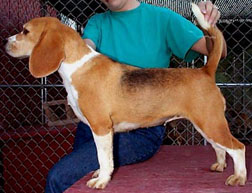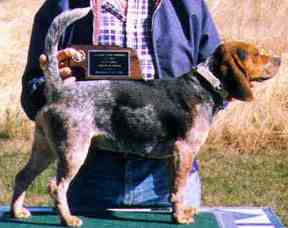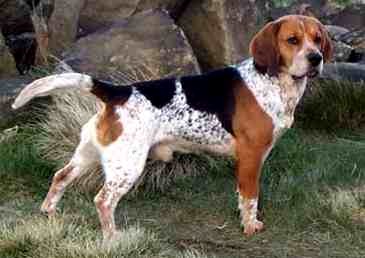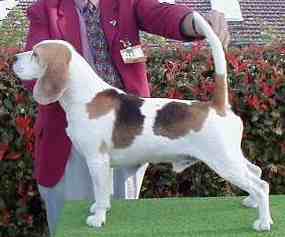|
|
||
|
A "Classic" Tri |
A "Shaded Tri" |
A different form of Shaded Tri |
Tri-Colors
|
|
||
|
A "Classic" Tri |
A "Shaded Tri" |
A different form of Shaded Tri |
 |
|
|
Two Different dogs exhibiting the "Faded Tri" coloration |
|
|
Andrew Smalley states in his Any True Hound Color booklet that "the varied shading of these tri-colour hounds can give the different patterns which some people give very different names to. For instance, where there is a lot of white and the colour patches are faded to give a mingling of black and tan hairs, some people within the show world would refer to these as hare pied. However, it is not the colour the hunting world recognizes as hare pied..."
One of many colored drawings from Andrew Smalley's book, showing the black and tan pattern. In beagles the dog would have varying degrees of white at the extremities and not be solidly colored, such as shown here. This is the basic background color for the beagle. All other colors are recessive to it.
|
|
| This dog is definitely a Blue-Ticked
Tri-color, even though there are many flecks of brown on the lower legs,
this is still referred to as "Blue-ticked". The "blue" is achieved by an
intermingling of white hairs among the darker black color, and is not
really a dilute blue. The extreme ticking seen in this dog, extending
even the length of the tail, is seen more often in field bred beagles
where so much ticking is not considered a fault by breeders. This dog
is most likely registered as a Black, White and Red with Ticking.
|

|
|
| In Any True
Hound Color, Andrew Smalley says of the mottles: "Sometimes you will
find on these tri-colours spots on the white areas in various degrees of
distribution. Some people call these mottles, but genetically, it is
impossible for them to be. These spots occur on a puppy turned six to
seven weeks and become denser with maturity, whereas the true mottles will
show its prospective colour from about four to five days." He further
says, The pigmentation of the skin in a mottled hound is a solid colour,
as is that of the blue roan Cocker and this is the acid test....Assuming
mottled parentage, you can identify your mottled puppies from a very early
age by looking at their feet. In a puppy which is to finish up tri-colour,
the soles of the feet will be pigmented in patches, whereas, the mottled
puppy will have pads of a mulberry colour at first, then black, because as
I have said, there will be no patches of pink on a mottle."
|
||
 |
This dog represents what is called a Mottled Tri-color, so called because of the mottling or ticking of both black and brown in the white areas. He is also a very good representative of the AKC color White, Black and Red. This is definitely a Red not Brown or Tan color. Mottling has more white background showing through than extreme ticking as above, and the "ticks" are clearer in color and often larger in size. |
| These dog are representative of what
would be termed Open or Broken Tri-Color, where white is the predominant
color. Such dogs would be designated as white, tan and black. The "Open"
designation usually refers to the white on the back, breaking up the
color. Below are different pattern of Open Tri-Color.
|

|